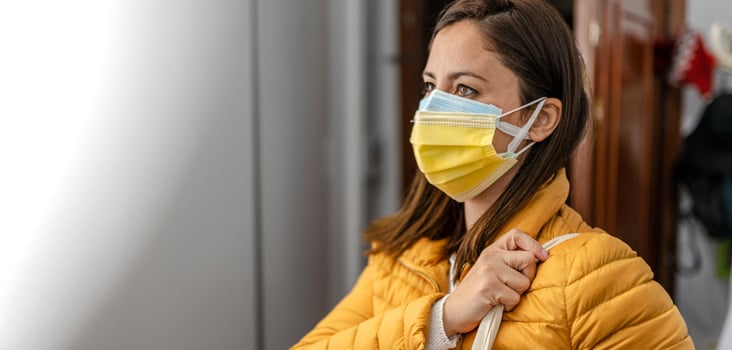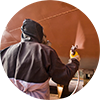
Update on COVID-19 Mask Safety in the Workplace
The future of masking against COVID-19
Encouraging your employees to wear a mask at work and elsewhere around people outside their immediate household is vital to occupational health and to halting the spread of COVID-19. Masks and social distancing need to continue into the foreseeable future.1 Masks not only serve a role in self-protection but also contribute to the safety of those in the immediate vicinity. Dr. Anthony Fauci, director of the National Institute of Allergy and Infectious Diseases, explains that, “Currently, we do not have enough data to be able to say with confidence that the vaccines can prevent transmission.”2
By complying with masking, social distancing, hand hygiene, and other recommended practices, your employees may make their mark in history. One other time, in the 1918-1919 influenza pandemic, U.S. employees faced requirements for face masks. In those days, many masks were hasty constructions of porous gauze and, unsurprisingly, not that effective.3 Widespread compliance with mask mandates today can make a big impact because we know more; the Centers for Disease Control and Prevention (CDC) advises on effective masking and provides regular updates to increase protection.
CDC recommendations and tips are included in this article updating the latest guidance on COVID-19 masking. Also, as a bonus, this article contains links to four resources designed to help you communicate mask facts to employees.
The first resource is a poster you can download, print, and display at work: How to Safely Wear and Take Off a Mask.4
As more employees become fully vaccinated, supervisors may be asked why face masks are still necessary. Dr. Fauci’s point about infection transmission is one of five on this list of “hip pocket” message points for supervisors:5
Why Fully Vaccinated Employees Need to Continue to Wear Masks
- No vaccine is 100 percent effective.
- Vaccines don’t provide immediate protection.
- COVID-19 vaccines may not prevent the spread of the virus to others.
- Masks help protect people with compromised immune systems.
- Masks protect against any coronavirus strain, including new variants.
CDC masking guidelines: Do’s and don’ts
Mask Do’s
The CDC recommends cloth masks with two or more layers of washable, breathable fabric. Other guidelines relate to the fit of the mask and care in putting masks on, taking masks off, and storing the mask for re-use:6
Mask fit
- The mask should completely cover the nose and contain a nose wire sewn into the fabric to prevent air from leaking out of the top of the mask.
- The mask should fit snugly around the sides of the face and chin with no gaps.
Mask use
- Before putting on the mask, wash hands or use a hand sanitizer. Do not touch the mask while wearing it.
- Remove the mask by the ear hoops or ties only and fold the outside corners together. Store the mask in a clean breathable paper bag or mesh bag.
- Wash or sanitize hands again after removing the mask.
Mask Don’ts
While the majority of employees will begin by carefully following guidelines, it doesn’t take long for some to veer off into sideroads of improvising their own mask methods, so reminders of proper procedures may be needed. These missteps – or “The Don’ts of COVID-19 Masking” – usually involve mask construction and lack of care in handling masks, such as:
Mask construction
- Masks should not be made of unbreathable fabric, like vinyl, or contain exhaust valves, vents, or openings.
- Face shields are not recommended in place of masks, even while their effectiveness is still being studied.
- Single-layer gaiters should not be worn. Either as constructed or as folded, gaiters should provider coverage of two or more layers.
- Do not use scarves, ski masks, or other similar cold weather apparel in place of recommended cloth masks.
Handling masks
- Any gaps or failure to properly cover the nose and mouth at all times when wearing a mask will compromise protection.
- The mask should not be allowed to hang from the neck or off one ear. The mask should not be worn on the forehead, under the nose, on the chin, or over only either the mouth or nose.
Here is a resource to check regularly and to share with others: CDC Mask Website: Use Masks to Slow the Spread of COVID-19.7
Five CDC tips to enhance mask effectiveness
Employees who want to take advanced measures to protect themselves, their families, and vulnerable coworkers and others are likely to appreciate learning these new tips.8 The CDC announced them in early February 2021:
- Use masks with a metal strip along the top of the nose bridge. This tip, mentioned earlier, is worth repeating because researchers have discovered that nasal cells are more likely to become infected or shed the coronavirus than even cells in the throat or lungs.9
- Wear a mask brace (a light-weight frame) over a surgical mask to hold the mask down and in place over the nose and cheeks.
- Use a “knot and tuck” technique to eliminate gaps along the cheek by tying a knot in the ear loops close to the mask. Here is a resource to help illustrate: Mask Safety: Knot and Tuck Technique Demonstrated. University of North Carolina Health.10
- Wear a cloth mask over a surgical mask to block more than 92 percent of particles from coughing.
- Check for mask gaps by cupping hands around the edges while inhaling and exhaling.
Making masks a part of lifestyle
Given that masks will be the universal “personal protective equipment” for the foreseeable future, you can encourage your employees to make masks part of their lifestyle – for example, try sharing the importance of wearing masks when working out at a local gym.
In late February 2021, the CDC announced that high-intensity aerobic workouts without masks can cause the virus to spread easily.11 A mask should be worn during the entire workout to reduce virus transmission, while also maintaining social distancing of at least six feet from others and keeping to well-ventilated spaces, the CDC says. Outdoor workouts are another option.
Researchers in Israel investigated whether wearing face masks during exercise would have any undesirable health effects. Wearing a cloth face mask during short-term, moderately strenuous aerobic exercise had only minor effects on heart rate, respiratory rate, blood pressure, oxygen saturation, and time to exhaustion. An N95 respirator, used by health care professionals, should not be worn during exercise because this leads to significantly higher increases in carbon dioxide concentrations in the lungs and potential respiratory failure, the study showed.12
One unpleasant consequence of wearing close-fitting face masks to work, outdoors, or during activities in some cases is eruption of a skin rash/rosacea, acne, or acute seborrheic dermatitis on the face due to the warm, moist environment masks can create. These instances have been documented in medical journals and were easily treated.13
As a final resource to share with your employees, here are the CDC’s recommendations on How to Store and Wash Masks.14
So, advise your employees: Mask up. And stay safe.
NOTES
1 Five Reasons to Wear a Mask Even After You’re Vaccinated. Kaiser Health News. January 15, 2021.
2 Dr. Fauci says it’s important to wear a mask even after getting the COVID vaccine. Here’s why. CNBC. February 4, 2021.
3 When Mask-wearing Rules in the 1918 Pandemic Faced Resistance. History.com. May 6, 2020.
4 How to Safely Wear and Take Off a Mask (Poster). Centers for Disease Control and Prevention.
5 Five Reasons to Wear a Mask Even After You’re Vaccinated. Kaiser Health News. January 15, 2021.
6 Your Guide to Masks. Centers for Disease Control and Prevention. Updated February 22, 2021.
7 CDC Mask Website: Use Masks to Slow the Spread of COVID-19. Centers for Disease Control and Prevention. February 16, 2021.
8 The CDC just outlined 5 tips to make your face mask more protective. Business Insider. February 11, 2021
9 Hou YJ, Okuda K, Edwards CE, et al. SARS-CoV2 Reverse Genetics Reveal a Variable Infection Gradient in the Respiratory Tract. Cell. July 23, 2020; 182(2): 429-446
10 Mask Safety: Knot and Tuck Technique Demonstrated. University of North Carolina Health. February 12, 2021.
11 COVID-19 spreads easily in gyms, CDC finds. Here’s how you can work out safely indoors. Yahoo News.
12 Epstein D, Korytny A, Isenberg Y, et al. Return to training in the COVID-19 era: The physiological effects of face masks during exercise. Scandinavian Journal of Medicine and Science in Sports. January 2021;31(1):70-75
13 Giacalone S, Minuti A, Spigariolo CB, Passoni E, Nazzaro G. Facial dermatoses in the general population due to wearing of personal protective masks during the COVID-19 pandemic: first observations after lockdown. Case Reports Clinical and Experimental Dermatology. March 2021;46(2):368-369.
14 How to Store and Wash Masks. Centers for Disease Control and Prevention.



